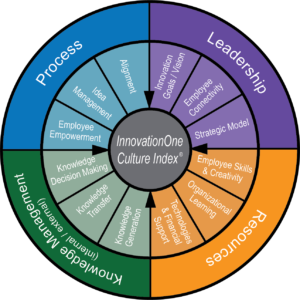Change is imperative for organizational success. The bedrock of organizations that achieve success is a culture of innovation. Yet many leaders resist these cultures of innovation. They may believe culture is too mushy to measure and manage or takes too much time, or perhaps they don’t think about it because it was never taught to them in business school.
A culture of innovation is when innovation is the DNA of a company. It is an environment that supports creative thinking and invites employees and external partners to propose ideas aligned to the innovation vision of the organization. Several characteristics mark these cultures. They are highly questioning, collaborative and disciplined, transparent, empowering, and willing to experiment and prototype. These cultures breakthrough hierarchy and boundaries to get answers, build trust, and tolerate failure in learning and improving innovation. Their collaboration and empowerment are balanced with individual and team accountability. But the organizations that do embrace cultures of innovation see improved company performance.
The evidence on cultures of innovation is overwhelming. Consider the following:
- Our research at InnovationOne, LLC shows that companies scoring in the top quartile of our InnovationOne Culture Index© reported higher financial
 performance by as much as 22%.
performance by as much as 22%. - Firms with innovative and adaptive cultures achieve extraordinary financial results, including nearly three times the review growth, 900% higher stock price growth, and an incredible 755% higher net income growth. This is the conclusion of John P. Kotter and James L Heskett in their book, Corporate Culture and Performance, 1992.
- Arthur D Little reports that companies with a passion for innovation benefit from an increase in EBIT of 13% and more than average performers and 30% time-to-break even.
- Our recently released joint study with the US Department of Energy shows that a higher innovation culture score at R&D labs leads to dramatically higher organizational performance. Improving a culture score by just one point (on our 100-point Culture Index©) can increase performance in innovation, commercial deployments, partnerships with industry, and academic publications by up to 30 percent.
Beyond the issue of improved performance and financial results, an MIT study released this year shows that strong, thriving cultures reduce employee turnover. MIT researchers uncovered that toxic organizational cultures drive employee turnover ten times more than pay.
Getting a culture of innovation right can mean a substantial improvement in performance, the ability to adapt to ever-changing external environments and more engaged and loyal employees.
Building a culture of innovation is not easy. But it is worth the effort and provides better business outcomes and financial results for companies and government agencies.
Below are the seven traits of highly innovative organizations:
1-Executives embrace innovation, create an innovative vision and strategies, and communicate them relentlessly.
While executives themselves don’t have to be innovators, they need to signal to their workforce and external partners that they embrace innovation and have a compelling vision and strategy.
compelling vision and strategy.
Our research with private industry and US DOE research labs shows that executives articulating their innovation visions and strategies and inviting employees and external partners to participate are the most impactful actions they can take to improve innovation. However, sustaining innovation cultures requires more than vision and encouragement, as you will see.
Executives in highly innovative organizations make innovation an important aspect of their strategic planning processes. Innovation is a way of thinking. Strategic planning is a process. Executives in highly innovative organizations make strategic planning action-orientated, not process orientated. These organizations think through their innovation agendas and develop detailed actions plans. High innovators relentlessly stick to their innovation plans but revise their goals and milestones to learn from their experimentation and external partners.
2-Employee and external partner creativity is unleashed, and learning is encouraged.
There is usually no shortage of creativity and suggestions from employees. To ignite employee creativity, executives must create transparent cultures of innovation and give employees permission to ask questions, make suggestions, and collaborate. For example, collaboration with external entities – vendors, customers, universities, startups, and financiers – is proving to be materially successful for highly innovative firms and presents a strategy shift to innovation.
Executives need to share what they know (short of proprietary information, of course) and invite employees and external partners to help solve problems and identify new business opportunities. When employees are intrinsically aligned with the company’s purpose, and when they believe that their suggestions will be taken seriously, and know they will be recognized for their achievements, a fountain of innovation will flow forth.
3-A clear process exists to move ideas forward.
Many innovative ideas die on the vine because there is no transparent process to advance them, experiment with them, gather analytics, prototype them, compare them with competing ideas, and decide which ideas to fund for commercialization. These processes need to be dynamic, transparent, and highly interactive. This is an area where collaborative digital technology can help, but without a culture that supports innovation, even technology can fail.
Overwhelmingly in our most recent organizational-wide surveys with The Conference Board, employees told us they lack the empowerment and process to advance new ideas efficiently and quickly. High innovators have invested in methods and tools to move ideas forward, and the investment is paying off. Our survey found that design thinking and stage-gate processes were the highest scoring methods for advancing innovation.
4-An innovation knowledge management system is in place.
Highly innovative companies create knowledge management platforms to collect information and share and transform this knowledge into better decisions. Our research with The Conference Board and Japanese Productivity Center found more than a 20 percent difference between high and low innovators related to knowledge management systems that fostered collaboration. Highly innovative organizations use real-time collaboration infrastructure. Employees on innovation teams in highly innovative organizations have access to digital libraries of information, and internal and external experts. The culture supports sharing and collaboration between experts with teams. As a result, they are faster to identify value-creating strategies and more efficient at bringing them to market.
5-Investment in resources, skills, time, advanced technology, digitization, and space are dedicated to supporting innovation.
Innovation needs investment. In some industries, the investment is simply time to allow employees to experiment. The investment often includes training employees on collaborative behaviors.
Our most recent global surveys show that investment in advanced technologies informs existing strategies and spurs new ideas. First, data analytics and
artificial intelligence are more widely adopted by high innovators. But, second, these technologies are used beyond singular “project” level initiatives and they have become engrained in the operational foundations to drive innovation.
Here’s an example of how different companies work. A low innovator will enact a data analytics project to gain insight into a product, service, or program. In contrast, a high innovator will embed data analytics into continuous analysis and predictive decision-making of its innovation knowledge management infrastructure. As a result, strategic choices are informed by real-time insight from predictive models embedded in the operations.
High innovators also successfully used advanced technologies such as artificial intelligence and supporting technologies such as crowdsourcing and innovation management software.
6-Innovation has enterprise-wide objectives, measures, and the organization’s sales, marketing, and operations are aligned to innovation goals.
Our research has consistently shown that high innovators have a much better innovation measurement platform to assess the progress of a company’s innovation platform. They also tend to better understand how organizational departments such as manufacturing, supply chain, sales, and marketing align their processes to support innovation. Every employee in these departments knows exactly what the innovation strategy is, and more importantly, their role in achieving it.
For example, supply chain will get involved early to determine who in their value chain may have the technology or expertise to assist an internal innovation team or find strategic external resources for innovation. This is not last-minute work. Our research shows that high innovators are not afraid to invest in the long-term and measure accordingly by every department. Conversely, low innovators emphasize short-term financial measures but do not develop robust measurement systems across the organization to support innovation.
7-Performance management systems incent and encourage innovation.
For many mature organizations and government agencies, performance management systems reinforce a safe and status quo culture to assure execution excellence. These cultures discourage risk-taking and collaboration. Enlightened executives know that they can keep the organization’s focus on meeting this quarter’s commitment to stakeholders while also creating a collaborative and learning culture for innovation. To achieve execution excellence — and innovation — a company’s performance management system needs to motivate meeting commitments while creating expectations for innovative behaviors and rewarding questioning, initiative, and reasoned risk-taking.
Innovation is not easy. But it is worth the effort and provides better business outcomes and financial results for companies and government agencies. The status quo saves the effort but is a failing business strategy.
Are you ready to improve your culture of innovation?
Contact us to learn more.
InnovationOne®, LLC helps organizations worldwide build a culture of innovation and make it sustainable. InnovationOne® uses a scientifically developed assessment to measure, benchmark, and improve your company’s culture and capability to innovate and enjoy better outcomes and financial results. Companies scoring in the top quartile of our InnovationOne Culture Index© reported higher financial performance by as much as 22 percent. Measure and ignite your culture of innovation. Contact us at [email protected].

